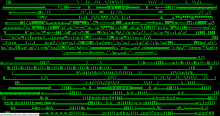/death/null

„It's a place to bury a hatchet.
Immortalise the ephemeral.
Make a meme memorial.
Mark a mortal thought.
An Obytuary.“
/death/null is a graveyard for digital files. each file you upload will be directly streamed to /dev/null on this system, the so called null device which is a kind of nirvana or black hole in a computer system. in the process, the system selects bytes from your file and calculates a digital fingerprint, creating an online gravestone. afterwards, you may wish to delete any copies remaining on your system. you can always return to visit the grave of your file on the graveyard.
but ...?
/death/null is anything you want it to be. it brings the finite nature of human existence to the digital world. it rejects the ways of global players like google and facebook who are collecting and storing big loads of personal data without permission and without offering anyone adequate tools to delete their own data. it is about a never-sent loveletter that you want lay to rest. /death/null can be used to practice voodoo; write down something you whish (not) to happen into a text file, a name of somebody you (don't) like, save your file and bury it. use /death/null if you want to use a completely useless file at least one time and if you want to eternalize the transient. it's for digital romanticists, it's about living and dead ideas and everything in between. /death/null deals with the concepts behind original, copy, copyright and plagiarism and it's, as already said, everything you want it to be history
the idea for /death/null is more than 10 years old. in the meantime we tried out a lot of things; to create a client/server platform for /death/null, so that the data already streamed is deleted immediately on the system of the user. we began to develop client software for windows, mac os and linux. we had a lot of ideas; the possibility to laying a wreath at the grave, to let the user print the gravestone to t-shirts or play a funeral march and a lot of other stuff. but it gets more and more complex, and in the end i have returned to my original concept - a consitent and pure solution, especially because it leaves the copy of the transferred file on the users system.






